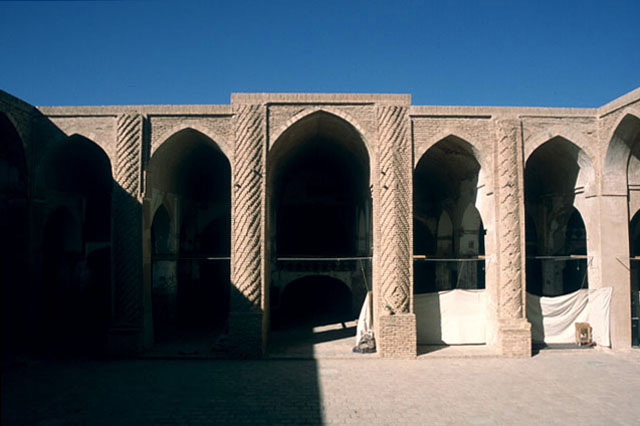one of the oldest in Persia
Byron, after having been in Yazd, on his way back to Isfahan stops in Na’in and Ardestan, in both cities he visits the Friday mosques. He records both his visits under the entry dated 31st March 1934. The first Friday Mosque he describes is the one in Na’in:
“I stopped at Nayin on the way back, to see the mosque, which dates from the ninth century and is one of the oldest in Persia. Its stucco ornament is filled with bunches of grapes, and suggests a transition of Hellenistic ideas through Sasanian art into Mohammedan.”
The Friday mosque of Na’in is dated to 960 c.e. circa. This date is based on the analysis of the original plan and on paleographic evidence since there is no foundation inscription. The mosque was originally built in the pre-Seljuk era, and was ampliated by the Seljuks: this ampliation makes the plan of the mosque quite irregular.

The focal point of the mosque is the area of the mihrab and the qibla wall: both are richly decorated. The mihrab does not contain any epigraphic band and ‘just’ display a wonderful stucco carving: vines, leaves, fruits, blossoms. The elements that compose the decoration point to the theme of fertility, a theme that can be linked to the position of the city: Na’in is set at the borders of the Dasht-i Kavir, the Great Salt Desert. The city was (and is) constantly threatened by drought and lack of water: the stucco carving of the mihrab can be then ascribed both to the hope to fertility and can be interpreted as a prayer to God. It is also easy to link the decoration to a reference to the Paradise.
On the qibla wall, instead, we find two inscriptions: both of them contain Qur’anic passages. They are important mainly because they are the earliest surviving examples of epigraphic friezes in Iran.

On the arch in front of the mihrab, a first, brief inscription, contains parts of Q 27:40 and Q 9:129:
In the name of God. This is from the favor of my Lord to test me whether I will be grateful or ungrateful. And whoever is grateful – his gratitude is only for [the benefit of] himself. And whoever is ungrateful – then indeed, my Lord is Free of need and Generous. But if they turn away, [O Muhammad], say, “Sufficient for me is Allah ; there is no deity except Him. On Him I have relied, and He is the Lord of the Great Throne.”
The first part is not uncommon in mosque inscriptions, and its content reminds the believers of God’s forgiveness. The passage Q 9:129, instead, is found in no other Iranian mosque. Its content, anyway, is linked to the idea that God is sufficient. This same theme is found again in the other, longer, inscription that is on the wall in front of the mihrab.

This second inscription starts with the Qur’anic quotation (Q 9:18 and part of Q 2:137) and ends with a pious phrase blessing the Prophet and his family.
In the name of God. The mosques of Allah are only to be maintained by those who believe in Allah and the Last Day and establish prayer and give zakah and do not fear except Allah, for it is expected that those will be of the [rightly] guided. Allah will be sufficient for you against them. And He is the Hearing, the Knowing. The is no God except God, Muhammad is the Prophet of Allah, God bless him and his family, that is good and pure.
Q 9:18 is quite common in mosques, this is easily explained since it refers openly to the mosque and to the duties of the good believer. In Q 2:137 the concept of “God is sufficient” for you, is repeated. Finally, the reference to Muhammad and particularly his family sets the mosque in a Shi’i context.

The inscriptions in the Friday Mosque of Na’in point out how the Qur’anic text, in earliest Iranian inscriptions, was deliberately chosen and how it composed an ‘iconographic message’. The fact that parts of different passages were juxtaposed and merged, means that the Qur’anic inscriptions had a homiletic message that was conveyed to the believers.
When Robert Byron visited the mosque, he did not focus on the inscriptions, instead, he was much more interested in the stucco decoration of the mihrab: there, he saw foreign influences, but he failed to trace any connections of those to the (geographical) context of the mosque. This said it is noteworthy that Byron decided to visit this mosque, as it is of paramount importance for the history of mosques in Iran.
Sources
Sheila Blair, The Monumental Inscriptions in Early Islamic Iran and Transoxiana, Brill, Leiden 1991, pp. 38-40.
Robert Hillenbrand, Islamic Architecture: Form, Function, and Meaning, Edinburgh University Press, Edinburgh 2000.
George Michell, Architecture of the Islamic World, Thames and Hudson, London 1978.
Bernard O’Kane, “Iran and Central Asia”, in Studies in Persian Art and Architecture, The American University in Cairo Press, Cairo 1995, pp. 119-139.
Arthur Upham Pope, “Architectural Ornament”, Arthur Upham Pope and Phyllis Ackerman (eds.), in A Survey of Persian Art from Prehistoric Times to the Present, Vol. 3 Architecture, Its Ornament, City Plans, Gardens, 3rd ed., Soroush Press, Tehran 1977, pp. 1258-1364.
And for other photos and a general description of the plan, go to Archnet.
2 Comments Add yours